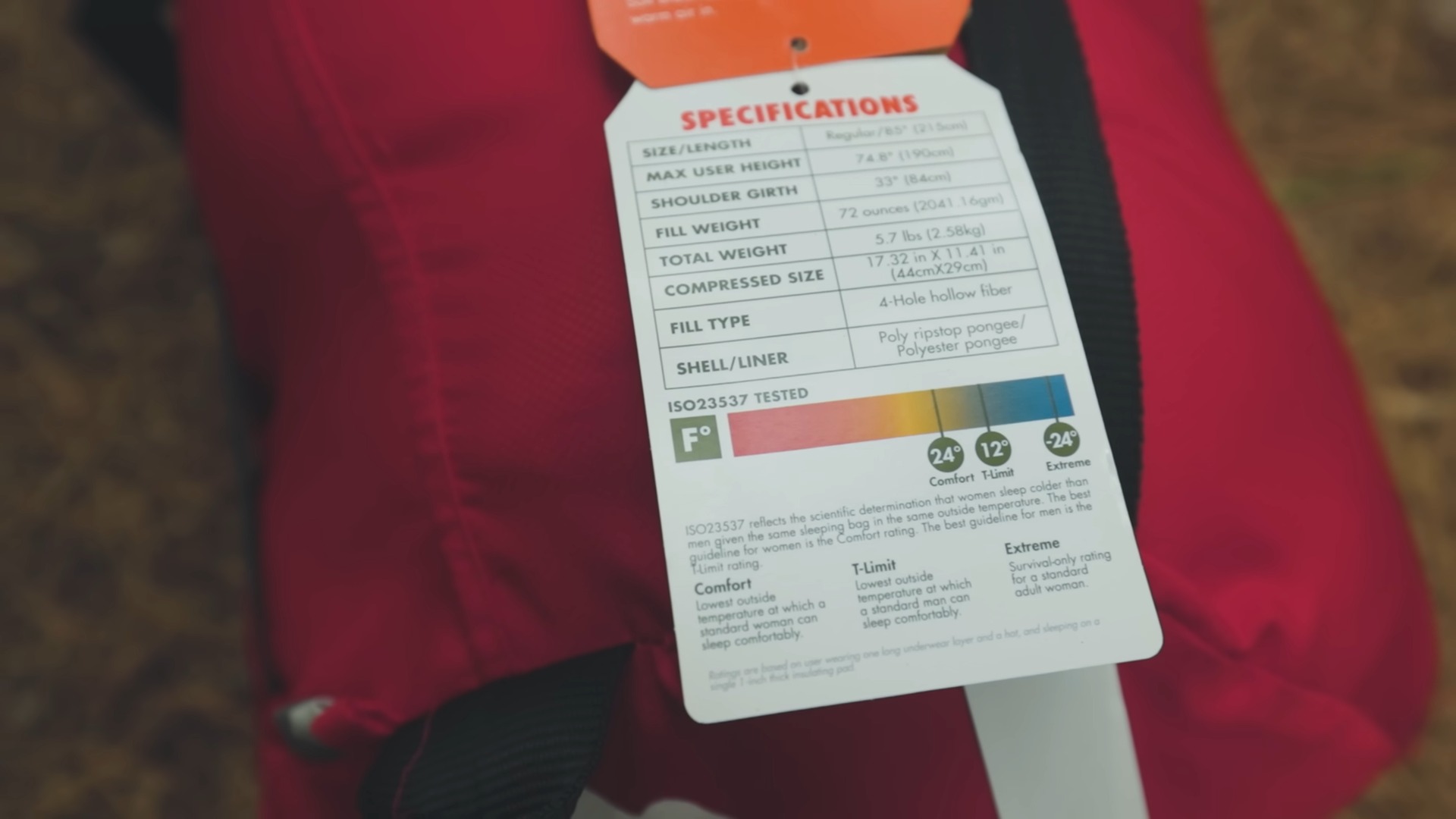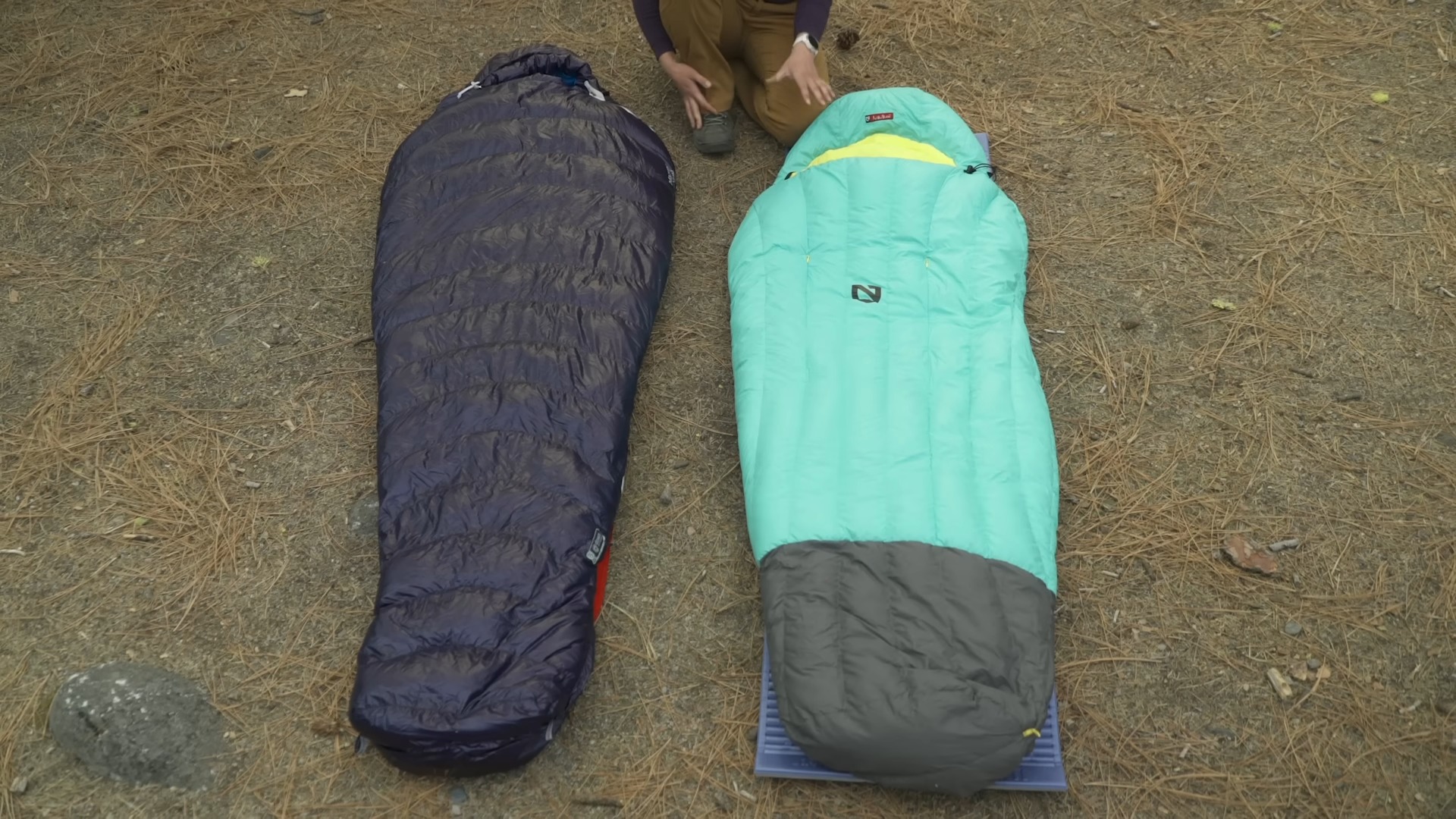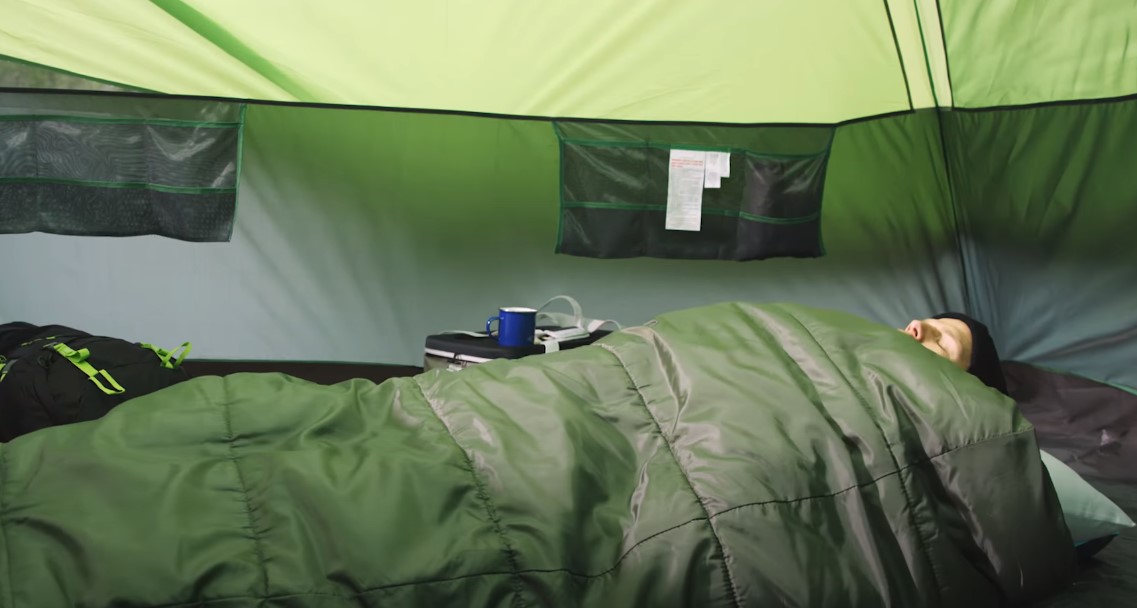As an outdoorsman with years of experience traveling and camping on various terrains and facing the whims of nature, I’ve come to the conclusion that a sleeping bag is, alongside a tent, the most important factor you should consider.
It’s not just a bed away from home; it’s your cocoon of warmth and comfort in the wilderness.
Choosing the right sleeping bag can mean the difference between a restful night and a shivering one, and with a plethora of options available, making an informed decision is paramount. Let me show you how to choose a perfect one.
Temperature Ratings Explained

Temperature ratings on sleeping bags are not just numbers; they are a guideline to help you understand in what conditions the bag will keep you warm in a tent. These ratings are not a guarantee as everyone’s body regulates temperature differently, and external conditions play a significant role.
Temperature also depends on the location as well.
Comfort vs. Limit vs. Extreme Ratings
Temperature ratings are categorized into three main types: comfort, limit, and extreme. Understanding these ratings is crucial for choosing a sleeping bag that will keep you warm in the conditions you plan to face.
| Rating Type | Definition | Ideal Usage |
|---|---|---|
| Comfort | The temperature at which a standard woman can expect to sleep comfortably in a relaxed position. | Mild weather camping |
| Limit | The lower end of the temperature scale at which a standard man can sleep for eight hours in a curled position without waking. | Cooler conditions |
| Extreme | The minimum temperature at which a standard woman can remain for six hours without risk of death from hypothermia (though frostbite is still possible). | Survival situations only |
Seasonal Sleeping Bags
The season when you plan to camp will dictate the type you’ll need.
Here’s a quick guide:
- Summer: Ideal for warm nights, usually rated at +35 degrees Fahrenheit and higher.
- Three-Season: Suitable for spring through fall, with ratings from +10 to +35 degrees.
- Winter: Designed for cold weather, typically rated at +10 degrees and below.
Sleeping Bags and Tents
Choosing a sleeping bag in relation to tent size is an important consideration for campers, as it ensures comfort, efficiency, and optimal use of space. Here are some key points to consider:
- Sleeping Bag Size and Tent Capacity: Match the sleeping bag size to the tent’s sleeping capacity. In a smaller, 2-person tent, a bulky sleeping bag can take up too much space, making it cramped and uncomfortable. Conversely, in larger tents, you have more flexibility to choose a larger, more comfortable sleeping bag.
- Space Efficiency: For backpacking tents, which are typically compact, opt for a sleeping bag that is lightweight and compressible. This will maximize the available space inside the tent and make it easier to carry in your backpack.
- Sleeping Bag Shape: Mummy-shaped sleeping bags are more space-efficient and better suited for smaller tents, as they take up less room. Rectangular sleeping bags offer more room to move but take up more space, making them more suitable for larger tents
- Sleeping Arrangement: If you plan to sleep more than one person in the tent, consider how multiple sleeping bags will fit together. Some sleeping bags can be zipped together to create a double bed, which can be a space-saving option in a larger tent.
Sleeping Bags and Different Camping Types
Choosing a sleeping bag for dry, primitive, and stealth camping requires a careful consideration of the specific conditions and challenges associated with each camping style. Here’s how to make an informed choice for each:
- Dry Camping:
- Dry camping often occurs in areas with extreme temperature fluctuations. Choose a sleeping bag with appropriate insulation for the expected temperature range.
- Even in dry areas, dew or frost can be a concern. A sleeping bag with some degree of water resistance is beneficial.
- In warmer, dry climates, a breathable sleeping bag can prevent overheating and ensure comfort.
- Primitive Camping:
- Primitive camping often involves hiking to remote locations. A durable, yet lightweight sleeping bag is ideal.
- Since primitive camping can bring you into a variety of environments, select a sleeping bag suitable for the lowest temperatures you might encounter.
- A sleeping bag that compresses well is easier to carry, leaving more room for other essential survival gear.
- Stealth Camping:
- For stealth camping, where blending into the environment is key, choose a sleeping bag in natural, subdued colors.
- As stealth camping locations can vary greatly, a versatile sleeping bag that’s adaptable to different temperatures and conditions is preferable.
- Consider a sleeping bag material that is quiet and doesn’t rustle much, to maintain a low profile while camping stealthily.
Types of Insulation

When it comes to insulation, we are talking about the key component that determines how warm and comfortable you’ll be throughout the night. There are two primary types of insulation used in sleeping bags: down and synthetic. Each has its own set of characteristics that make it suitable for different conditions and personal preferences.
Down Insulation
Down insulation is made from the plumage found beneath the feathers of ducks and geese. It’s renowned for its excellent warmth-to-weight ratio, meaning it provides a lot of warmth without adding much weight to your pack.
Here’s what you need to know about down:
- Warmth: Down is exceptionally efficient at trapping heat and is known for its lofty, fluffy appearance, which retains body heat.
- Weight: It’s lighter than synthetic insulation, making it a favorite for backpackers who need to minimize their load.
- Compressibility: Down compresses very well, which means it can be packed down small, taking up less space in your backpack.
- Durability: With proper care, down sleeping bags can last many years.
- Cost: Down is generally more expensive than synthetic insulation.
- Water Resistance: Traditional down loses its insulating properties when wet, but many down sleeping bags now use hydrophobic down that resists water.
Synthetic Insulation
Synthetic insulation is made from polyester fibers that mimic the structure of down but are less expensive and provide insulation even when wet.
Here are the details on synthetic insulation:
- Warmth: While not as warm as down by weight, synthetic insulation performs better than down when wet.
- Weight: Synthetic bags tend to be heavier, which can be a drawback for long-distance treks.
- Compressibility: Synthetic insulation doesn’t pack down as small as down and will take up more space in your pack.
- Durability: Synthetic fibers break down more quickly than down, meaning it may lose loft and warmth over time.
- Cost: Synthetic sleeping bags are generally more affordable, making them a good choice for casual campers and those on a budget.
- Water Resistance: The biggest advantage of synthetic insulation is its ability to retain warmth when wet, making it ideal for damp climates.
Hybrid Insulation
Some sleeping bags feature hybrid insulation, combining both down and synthetic materials to maximize the benefits of both. These bags aim to strike a balance between warmth, weight, and water resistance.
Specialty Insulations
In addition to down and synthetic, there are also specialty insulations, such as:
- Water-Resistant Down: Treated with a durable water repellent (DWR) to protect the down from moisture.
- Sustainable Insulation: Made from recycled materials or responsibly sourced down to minimize environmental impact.
Different Shapes and Features
The shape of your sleeping bag is not just about personal preference; it’s about efficiency. The right shape can enhance warmth and comfort, while the wrong one can leave you cold or constricted.
Mummy vs. Rectangular vs. Semi-Rectangular
Each shape has its own set of advantages:
- Mummy: Tapered at the feet for maximum warmth and weight efficiency.
- Rectangular: Offers more room to move around but can be less warm.
- Semi-Rectangular: A compromise between the two, offering a balance of space and warmth.
Special Features to Consider
Beyond shape, there are features that can greatly enhance your sleeping experience:
- Hoods: For added warmth around your head.
- Draft Collars: To prevent heat from escaping around your neck.
- Zippers: For ease of entry and ventilation options.
- Pockets: Handy for storing small items like a headlamp.
Size and Fit

The fit of your sleeping bag is another critical factor. A bag that’s too large will have excess space that your body will need to heat up, making it less efficient. Conversely, a bag that’s too small can restrict movement and even compress the insulation, reducing its effectiveness.
Importance of Proper Fit
A well-fitting sleeping bag should feel snug but not tight. It should allow you to roll over and stretch out without too much excess fabric. Here are some tips for choosing the right size:
- Consider your height and shoulder width to find a bag that’s the right length and girth.
- Think about your sleep style; if you move around a lot, you might want a roomier bag.
Women-Specific and Youth Variants
Women and young campers often have different body shapes and temperature regulation needs than men. Women-specific and youth sleeping bags are designed to address these differences.
| Bag Type | Features | Benefits |
|---|---|---|
| Women-Specific | Tailored fit, extra insulation at critical areas | Better warmth and comfort for female physiology |
| Youth | Proportionally sized, adjustable features | Grow with the camper, provide a snug fit for smaller bodies |
Care and Maintenance
Ensuring your sleeping bag remains a reliable piece of equipment for your outdoor adventures requires a commitment to regular care and maintenance. Just as you need to clean your tent, you must do it for other gear, including sleeping bag.
Just as you wouldn’t neglect the upkeep of your car, your sleeping bag demands attention to detail to sustain its performance and extend its lifespan. Frequent cleaning is a must.
Let’s explore the nuances of keeping your sleeping bag in prime condition.
Proper Cleaning and Storage
The way you clean and store your sleeping bag can have a profound impact on its longevity. Here’s a deeper dive into the best practices for cleaning and storage:
- Washing: Always adhere to the manufacturer’s instructions when washing your sleeping bag. Typically, down bags require a gentle, non-detergent cleaner and should be washed in a large, front-loading washing machine.
- Synthetic bags are less delicate but still require care to avoid damaging the insulation.
- Drying: Air drying is the safest method, especially for down sleeping bags. If you must use a dryer, opt for a low heat setting and consider adding tennis balls to break up any clumps of insulation. Patience is key; drying a sleeping bag can take several hours.
- Storage: Never store your sleeping bag compressed in its stuff sack as this can damage the fill. Instead, use a large, breathable storage bag or hang it in a dry, cool place. This allows the insulation to remain lofted and prevents the growth of mold and mildew.
Longevity Tips

Beyond cleaning and storage, there are regular maintenance tasks that can help preserve the quality of your sleeping bag:
- Air Out: After each trip, turn the sleeping bag inside out and air it thoroughly. This helps to evaporate any residual moisture and reduces odor buildup. If possible, do this in a shaded area since UV rays can degrade the fabric over time.
- Spot Cleaning: For minor spills or stains, spot cleaning is often sufficient and less stressful on the fabric. Use a mild soap and a soft sponge or cloth to gently clean the affected area.
- Reapply Treatments: Over time, the water-repellent finish on your sleeping bag may begin to wear off. Reapplying a DWR (durable water repellent) treatment can restore its water resistance. Ensure its is clean and dry before applying any treatment, and follow the manufacturer’s guidelines.
- Inspect for Damage: Regularly inspect your sleeping bag for any signs of wear and tear. Look for holes, tears, or seams that may need repairing. Many minor issues can be fixed with a repair kit or by a professional, preventing them from becoming major problems.
- Avoid Harsh Chemicals: When cleaning or treating, avoid harsh chemicals that can break down the materials and reduce the insulation’s effectiveness.
- Professional Cleaning: Consider having your sleeping bag professionally cleaned every few years, especially if it’s down-filled. Professionals have the experience and equipment to clean it thoroughly without causing damage.
Sleeping Bags and Stoves
Choosing a sleeping bag in relation to your backpacking stove involves considering the environment and conditions you’ll be camping in, which are often the same factors influencing your stove choice.
Here’s how to align your sleeping bag selection with your stove choice:
- Temperature Rating: Match your sleeping bag’s temperature rating with the conditions you expect, influenced by your stove’s capabilities. For instance, if you’re using a winter stove for cold-weather camping, ensure your sleeping bag is rated for low temperatures. Conversely, for summer camping with a lightweight stove, a less insulated sleeping bag might suffice.
- Size and Weight: If you’re backpacking and need to carry a lightweight, compact stove, opt for a sleeping bag with similar properties. Ultra-light sleeping bags are ideal for hikers who use compact stoves and need to minimize their load.
- Moisture Resistance: In wet conditions, where you might use a stove that works well in damp environments, choose a sleeping bag with water-resistant or quick-drying features. This is especially important if you cook near your sleeping area, as humidity and condensation can increase.
- Material and Insulation: Consider the insulation type of your sleeping bag. Down insulation offers high warmth-to-weight ratio, suitable for colder conditions where a more robust stove is needed. Synthetic bags are better for damp conditions and align with stoves designed for wet weather.
- Ventilation: If you’re camping in a warmer climate with a simple, portable, clean stove, look for a sleeping bag with good ventilation options to avoid overheating.
- Safety Considerations: Ensure your sleeping bag material is flame-retardant or resistant, especially if you’re cooking near your sleeping area. This is crucial to prevent accidents, particularly in confined spaces or when using stoves inside tents you’ve raised.
- Space in Tent: The size of your sleeping bag should complement the space available in your tent, which also accommodates your cooking gear. Ensure that both your sleeping bag and stove fit comfortably within your camping setup without overcrowding.
FAQs
How long does a sleeping bag last?
With proper care, a good quality sleeping bag can last for 10 years or more.
Can I use a sleeping bag liner for extra warmth?
Yes, liners can add warmth and also keep your sleeping bag cleaner.
How can I test a sleeping bag before buying?
Try it in the store if possible, or rent a similar model to test in the field.
Do I need a water-resistant sleeping bag?
A water-resistant bag is beneficial in damp environments to protect the insulation from moisture.
Are there eco-friendly sleeping bag options?
Yes, look for bags with responsibly sourced down or recycled synthetic fill.
The Bottom Line
In my years of exploring the great outdoors, I’ve learned that a sleeping bag is not just a piece of gear; it’s a trusted ally against the elements.
Remember, the best sleeping bag for you is the one that meets your specific needs in terms of warmth, comfort, and functionality.
Take the time to choose wisely, and your sleeping bag will become a cornerstone of countless happy memories under the stars.
My name is Lazar, with over 8 years of dedicated camping across various terrains, I have garnered a significant expertise in evaluating camping gear for reliability and performance. My adventures have taken me through thick forests, along serene lakes, and atop remote hills, each experience sharpening my understanding of essential camping gear. Through hands-on use and thorough testing, I’ve honed my ability to discern the quality and practicality of various camping equipment, ensuring they stand up to the challenges posed by the outdoor environment. This extensive field experience has equipped me with the knowledge to share valuable gear insights, aiding fellow campers in their outdoor pursuits.